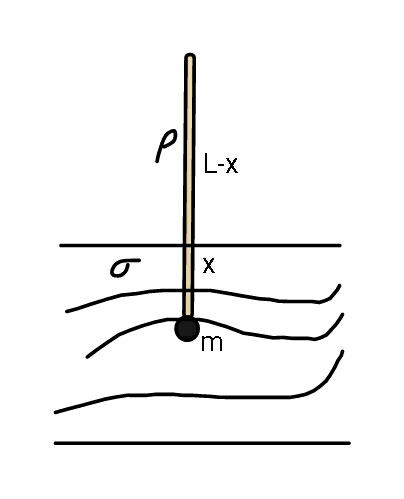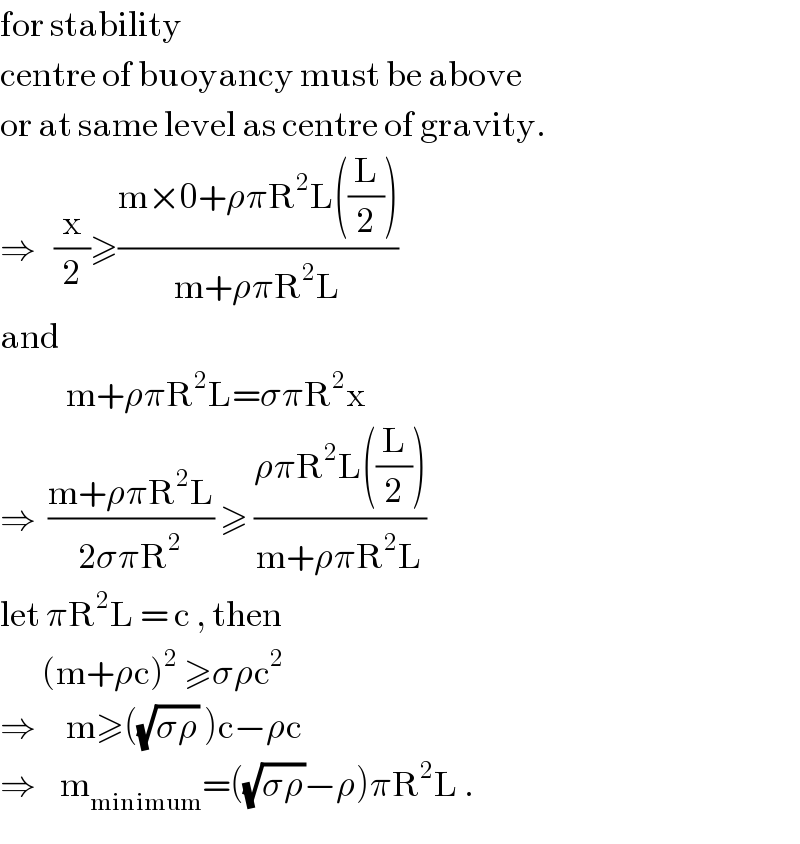Question Number 57114 by Tinkutara last updated on 30/Mar/19

Commented by ajfour last updated on 30/Mar/19

Commented by mr W last updated on 31/Mar/19

$${nice}\:{solution}\:{sir}! \\ $$$${let}'{s}\:{say}\:{m}>{m}_{{min}} .\:{what}\:{is}\:{the}\:{periode} \\ $$$${of}\:{the}\:{swinging}\:{motion}\:{of}\:{the}\:{stick}? \\ $$
Commented by ajfour last updated on 31/Mar/19

$$\mathrm{should}\:\mathrm{viscosity}\:\mathrm{be}\:\mathrm{taken}\:\mathrm{into} \\ $$$$\mathrm{consideration},\:\mathrm{Sir}? \\ $$
Commented by mr W last updated on 31/Mar/19

$${no}.\:{only}\:{weight}\:{of}\:{stick}\:{and}\:{buoyant} \\ $$$${force}\:{act}.\:{stability}\:{means}\:{the}\:{buoyant} \\ $$$${force}\:{brings}\:{the}\:{stick}\:{always}\:{to}\:{its} \\ $$$${original}\:{position}. \\ $$
Answered by ajfour last updated on 30/Mar/19

$$\mathrm{for}\:\mathrm{stability}\: \\ $$$$\mathrm{centre}\:\mathrm{of}\:\mathrm{buoyancy}\:\mathrm{must}\:\mathrm{be}\:\mathrm{above} \\ $$$$\mathrm{or}\:\mathrm{at}\:\mathrm{same}\:\mathrm{level}\:\mathrm{as}\:\mathrm{centre}\:\mathrm{of}\:\mathrm{gravity}. \\ $$$$\Rightarrow\:\:\:\frac{\mathrm{x}}{\mathrm{2}}\geqslant\frac{\mathrm{m}×\mathrm{0}+\rho\pi\mathrm{R}^{\mathrm{2}} \mathrm{L}\left(\frac{\mathrm{L}}{\mathrm{2}}\right)}{\mathrm{m}+\rho\pi\mathrm{R}^{\mathrm{2}} \mathrm{L}} \\ $$$$\mathrm{and}\:\: \\ $$$$\:\:\:\:\:\:\:\:\:\:\:\mathrm{m}+\rho\pi\mathrm{R}^{\mathrm{2}} \mathrm{L}=\sigma\pi\mathrm{R}^{\mathrm{2}} \mathrm{x} \\ $$$$\Rightarrow\:\:\frac{\mathrm{m}+\rho\pi\mathrm{R}^{\mathrm{2}} \mathrm{L}}{\mathrm{2}\sigma\pi\mathrm{R}^{\mathrm{2}} }\:\geqslant\:\frac{\rho\pi\mathrm{R}^{\mathrm{2}} \mathrm{L}\left(\frac{\mathrm{L}}{\mathrm{2}}\right)}{\mathrm{m}+\rho\pi\mathrm{R}^{\mathrm{2}} \mathrm{L}} \\ $$$$\mathrm{let}\:\pi\mathrm{R}^{\mathrm{2}} \mathrm{L}\:=\:\mathrm{c}\:,\:\mathrm{then} \\ $$$$\:\:\:\:\:\:\:\left(\mathrm{m}+\rho\mathrm{c}\right)^{\mathrm{2}} \:\geqslant\sigma\rho\mathrm{c}^{\mathrm{2}} \\ $$$$\Rightarrow\:\:\:\:\:\mathrm{m}\geqslant\left(\sqrt{\sigma\rho}\:\right)\mathrm{c}−\rho\mathrm{c} \\ $$$$\Rightarrow\:\:\:\:\mathrm{m}_{\mathrm{minimum}} =\left(\sqrt{\sigma\rho}−\rho\right)\pi\mathrm{R}^{\mathrm{2}} \mathrm{L}\:. \\ $$
Commented by Tinkutara last updated on 30/Mar/19
Thank you Sir!
But what was wrong with previous answer?
Commented by ajfour last updated on 30/Mar/19

$$\mathrm{previous}\:\mathrm{answer}\:\mathrm{should}\:\mathrm{go}\:\mathrm{for} \\ $$$$\mathrm{maximum}\:\mathrm{mass}\:\mathrm{that}\:\mathrm{be}\:\mathrm{attached} \\ $$$$\mathrm{to}\:\mathrm{stick}\:\mathrm{to}\:\mathrm{keep}\:\mathrm{it}\:\mathrm{afloat}\:\mathrm{still},\:\mathrm{i}\:\mathrm{think}. \\ $$
